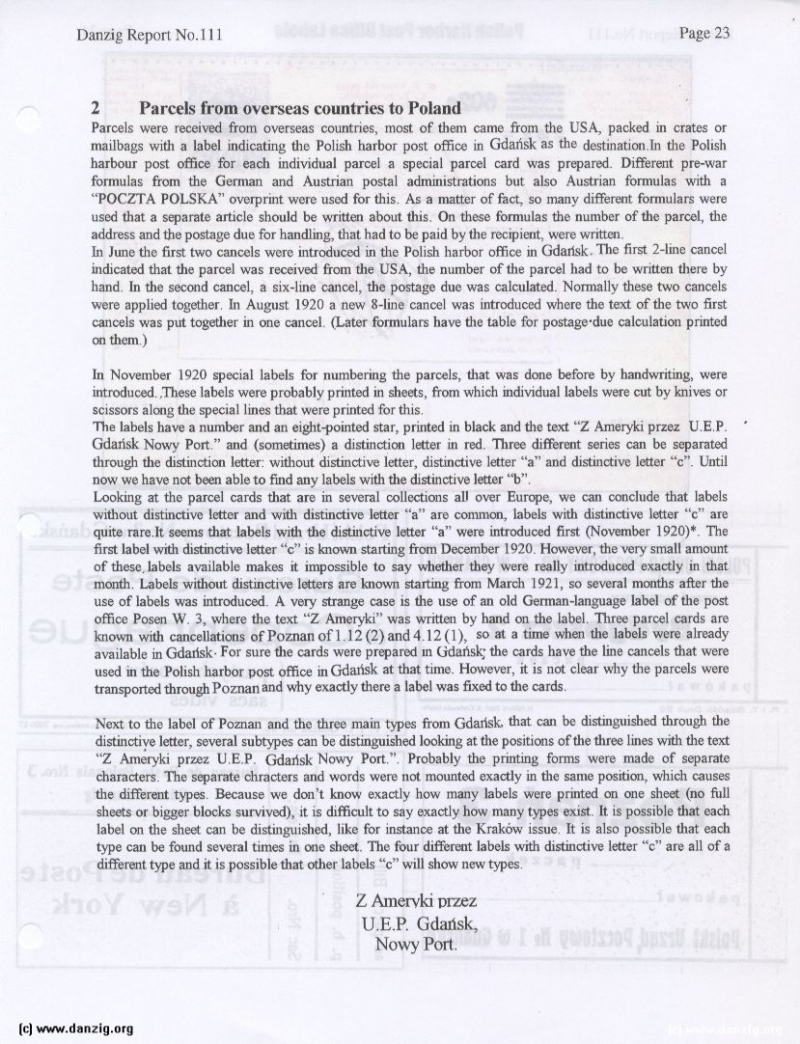
Parcels from overseas countries to Poland
Parcels were received from overseas countnes, most of them came from the USA, packed in crates or mailbags with a label indicating the Polish harbor post office in Gdañsk as the destination In the Polish harbour post office for each individual parcel a special parcel card was prepared. Different pre-war formulas from the German and Austrian postal administrations but also Austrian formulas with a “POCZTA POLSKA’ overpnnt were used for this. As a matter of fact, so many different formulars were used that a separate article should be written about this. On these formulas the number of the parcel, the address and the postage due for handling, that had to be paid by the recipient, were written
In June the first two cancels were introduced in the Polish harbor office in Gdailsk. The first 2-line cancel indicated that the parcel was received fran the USA, the number of the parcel had to be written there by hand. in the second cancel, a six-line cancel, the postage due was calculated. Normally these two cancels were applied together. In August 1920 a new 8-line cancel was introduced where the text of the two first cancels was put together ii one cancel (Later formulars have the table for postageduc calculation printed anthem)
In November 1920 special labels for numbering the parcels, that was done before by handwriting, were introduced. These labels were probably printed in sheets, from which individual labels were cut by knives or scissors along the special lines that were printed for this.
The labels have a number and an eight-pointed star, printed in black and the text “Z Arneryki przez U.E.P Gdaiisk Nowy Poit.” and (sometimes) a distinction letter in red. Three different series can be separated through the distinction letter: without distinctive letter, distinctive letter “a” and distinctive letter “C”. Until now we have not been able to find any labels with the distinctive letter “b”.
Looking at the parcel cards that are in several collections all over Eurie, we can conclude that labels without distinctive letter and with distinctive letter “a” are common, labels with distinctive letter “c” arc quite rare It seems that labels with the distinctive letter “a’ were introduced first (November 1920)’. The first label with distinctive letter “c’ is known starting from December 1920. However, the very small amount of these, labels available makes it impossible to say whether they were really introduced exactly in that month. Labels without distinctive letters are known starting from March 1921, so several months after the use of labels was introduced A very strange case is the use of an old German-language label of the post office Posen W. 3, where the text “Z Ameryki” was written by hand on the label. Three parcel cards are known with cancellations ofPoznanofl.12(2)and4.12(1), so at a time when the labels were already available in Gdailsk For sure the cards were prepared in (idataslç the cards have the line cancels that were used in the Polish harbor post office in Gdaisk at that time. However, it is not clear why the parcels were transported through Poznan and why exactly there a label was fixed to the cards
Next to the label of Poznan and the three main types from Gdai’isk. that can be distinguished through the distinctive letter, several subtypes can be distinguished looking at the positions of the three lines with the text “Z Amesyki przez U.E.P (3daj’isk Nowy Port,”. Probably the printing forms were made of separate characters The separate chracters and words were not mounted exactly in the same position. which causes the different types. Because we don’t know exactly how many labels were printed on one sheet (no full sheets or bigger blocks survived), it is difficult to say exactly how many types exist It is possible that each label on the sheet can be distinguished, like for instance at the Krakow iSSUe It is also possible that each type can be found several times in one sheet. The four different labels with distinctive letter “c” are all of a different type and it is possible that other Labels “c” will show new types.
Danzig Report Vol. 1 - Nr. 111 - April - May - June - 2001, Page 23.
Hits: 3131
Added: 29/07/2015
Copyright: 2025 Danzig.org

